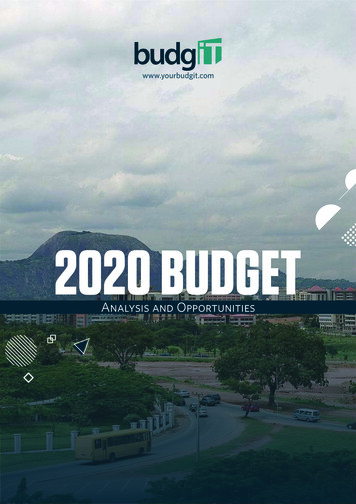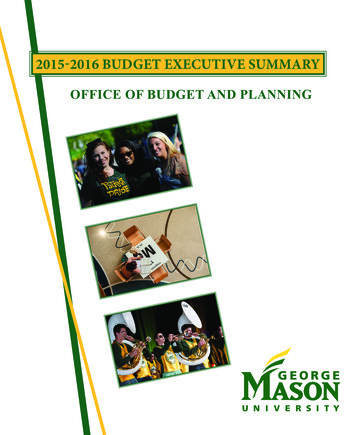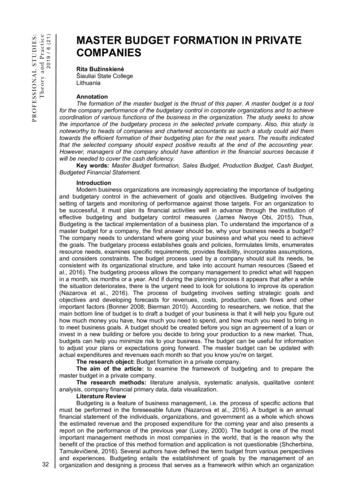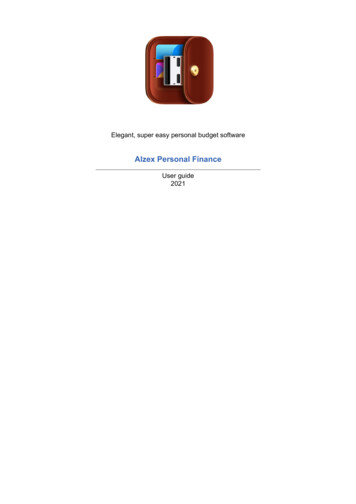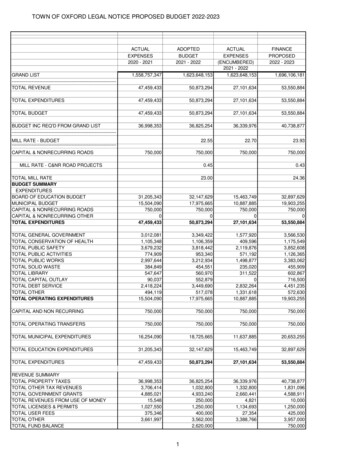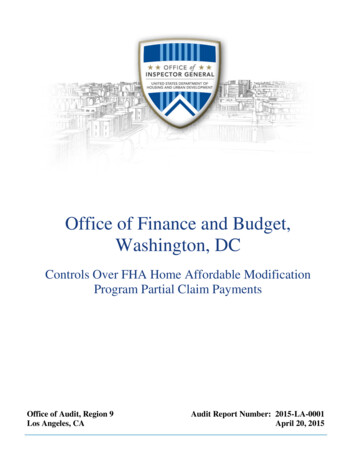
Transcription
Office of Finance and Budget,Washington, DCControls Over FHA Home Affordable ModificationProgram Partial Claim PaymentsOffice of Audit, Region 9Los Angeles, CAAudit Report Number: 2015-LA-0001April 20, 2015
To:George Rabil, Deputy Assistant Secretary for Finance and Budget, HW//SIGNED//From:Tanya E. Schulze, Regional Inspector General for Audit, 9DGASubject:HUD’s Claim Payment System Did Not Always Identify Ineligible FHA-HAMPPartial ClaimsAttached is the U.S. Department of Housing and Urban Development (HUD), Office of InspectorGeneral’s (OIG) final results of our review of HUD’s controls over the claim payment system forthe Home Affordable Modification Program partial claim option.HUD Handbook 2000.06, REV-4, sets specific timeframes for management decisions onrecommended corrective actions. For each recommendation without a management decision,please respond and provide status reports in accordance with the HUD Handbook. Please furnishus copies of any correspondence or directives issued because of the audit.The Inspector General Act, Title 5 United States Code, section 8M, requires that OIG post itspublicly available reports on the OIG Web site. Accordingly, this report will be posted athttp://www.hudoig.gov.If you have any questions or comments about this report, please do not hesitate to call me at213-534-2471.
Audit Report Number: 2015-LA-0001Date: April 20, 2015HUD’s Claim Payment System Did Not Always Identify Ineligible FHAHAMP Partial ClaimsHighlightsWhat We Audited and WhyWe audited the U.S. Department of Housing and Urban Development (HUD), Federal HousingAdministration’s (FHA) Home Affordable Modification Program (HAMP) partial claim option.We audited the FHA-HAMP partial claim option because we had not reviewed the program since2011 and the requirements had changed. Our audit objective was to determine whether HUDhad adequate controls over FHA-HAMP partial claim payments.What We FoundHUD’s claim payment controls for the FHA-HAMP partial claim option were not adequate.Specifically, HUD’s claim system allowed payment of (1) more than one claim with amodification or FHA-HAMP option in a 24-month period, (2) duplicate claims, (3) partial claimsin excess of 30 percent of the unpaid principal balance at initial default, and (4) non-HAMPpartial claims after HUD discontinued this claim type. These conditions occurred because HUDdid not design and implement sufficient claim payment controls to detect and prevent processedclaims that did not meet HUD requirements. As a result, HUD paid more than 22 million inunsupported claims and 103,925 in ineligible claims that did not meet HUD requirements.What We RecommendWe recommend that the Deputy Assistant Secretary for Finance and Budget (1) develop andimplement controls to detect and prevent payment of claims that violate HUD requirements, (2)provide support of eligibility or require repayment for more than 22 million in claims that didnot meet HUD requirements, and (3) require repayment of 103,925 for ineligible claims.
Table of ContentsBackground and Objective.3Results of Audit .4Finding 1: HUD’s Claim Payment System Did Not Always Identify Ineligible FHAHAMP Partial Claims. 4Scope and Methodology .7Internal Controls .9Appendixes .10A. Schedule of Questioned Costs . 10B. Auditee Comments and OIG’s Evaluation . 11C. Criteria . 15D. Details of Claims With a Modification or FHA-HAMP Option Within 24 Months. 18E. Potential Duplicate Claims Identified . 26F. Partial Claims Paid Above 30 Percent of the Initial Unpaid Balance. 272
Background and ObjectiveIn 1934, Congress created the Federal Housing Administration (FHA), which provides mortgageinsurance on loans made by FHA-approved lenders throughout the United States and itsterritories. Under the program, lenders bear less risk because FHA will pay a claim to the lenderin the event of a homeowner’s default; however, loans must meet certain requirementsestablished by FHA to qualify for insurance.FHA loss mitigation delegates to lenders both the authority and the responsibility to use certainactions and strategies to assist borrowers in default or imminent default to retain their homes andreduce losses to the insurance fund that result from mortgage foreclosures. Lenders may use anyof several loss mitigation options that lead to home retention. After evaluating a delinquentborrower for informal and formal forbearance plans, servicers must consider FHA’s lossmitigation options in the following order: (1) special forbearances; (2) loan modifications; and(3) FHA’s Home Affordable Modification Program (HAMP).The U.S. Department of Housing and Urban Development (HUD) created the FHA-HAMP lossmitigation home retention option in response to the Helping Families Save Their Home Act of2009. FHA-HAMP typically involves the combination of a loan modification and a partialclaim. However, with the issuance of Mortgagee Letter 2012-22 on November 16, 2012, FHAHAMP may now involve the use of one or both of those loss mitigation options.From July 1, 2012 to January 24, 2015, HUD paid more than 6.5 billion for 261,637 FHAHAMP partial notes and more than 107.5 million in incentive fees associated with the claims.Our objective was to determine whether HUD had adequate controls over FHA-HAMP partialclaim payments.3
Results of AuditFinding 1: HUD’s Claim Payment System Did Not Always IdentifyIneligible FHA-HAMP Partial ClaimsHUD’s claim payment system did not always identify ineligible FHA-HAMP partial claims.Specifically, the system allowed payment of (1) more than one claim with a previousmodification or FHA-HAMP option in a 24-month period, (2) duplicate claims, (3) partial claimsin excess of 30 percent of the unpaid balance at the time of default, and (4) non-HAMP partialclaims after HUD discontinued this claim type. The deficiencies occurred because HUD did notdesign and implement sufficient claim payment system controls. As a result, HUD could notsupport that approximately 22.5 million in claims paid was eligible and could not ensure theeligibility of future claims submitted.HUD Paid More Than One Claim With a Modification or FHA-HAMP option Within a 24Month PeriodHUD’s Mortgagee Letter 2012-22 states that to qualify for an FHA-HAMP option, the borrowermust not have received a stand-alone modification or FHA-HAMP option in the previous 24months (See appendix C for criteria). HUD had an edit code in its system intended to catchinstances in which a servicer submitted a claim that did not meet this criterion. However, wereviewed HUD system data for claims paid between November 16, 2012, and January 17, 2015,and identified 705 FHA-HAMP partial claims for amounts totaling approximately 22.2 millionthat had a stand-alone modification or FHA-HAMP option within the prior 24 months (Seeappendix D). 1 HUD did not adequately design its edit codes to identify FHA-HAMP options thatviolated this requirement.HUD Paid Duplicate ClaimsHUD’s claim payment system was set up to stop payment if a servicer submits a claim for thesame case number with matching partial note agreement dates. We identified 21 partial claimswith different agreement dates that appeared to be duplicate payments because the partial noteamounts matched (See appendix E).HUD reviewed documentation for the 21 potential duplicate claims identified and determinedthat 16 of the claims were duplicate payments. The remaining five claims were not duplicates,1Because HUD did not maintain sufficient data to determine which loan modifications were tied to a concurrentpartial claim and which were distinct loss mitigation actions, our audit testing was restricted. For each of the 705apparent violations identified, the claims appeared to be distinct loss mitigation actions because the agreement andpayment dates were more than 90 days apart and the unpaid balance reported for each claim was different. As aresult, we could not determine eligibility based on the data alone, and HUD would need to review the supportingdocumentation.4
four had the same dollar amount because the servicer accidently reported an incorrect amount forthe second claim, and one was a distinct claim for the same dollar amount. HUD held theservicer responsible for the difference. HUD received payment for 10 of the duplicate payments,but it was unclear whether it requested repayment or the servicer initiated the repayment. As aresult of our review, HUD sent billing letters to servicers for the six other duplicate payments inthe amount of 103,925. After we brought the issue to HUD’s attention, HUD updated itssystem so it would not automatically pay the servicer when the partial claim amounts matchedand that the system would flag these cases for further review.HUD Paid Claims in Excess of 30 Percent of the Unpaid Principal BalanceHUD had an edit code in its system intended to identify instances in which the cumulative partialclaim exceeds 30 percent of the unpaid balance. According to HUD, there was some confusionconcerning which unpaid balance to use. HUD Mortgagee Letter 2012-22 stated that themaximum value of all partial claims for a given loan could not exceed 30 percent of theoutstanding unpaid principal balance as of the date of default. However, HUD updated thelanguage in Mortgagee Letter 2013-32 to state that the partial claims were limited to 30 percentof the unpaid principal balance at time of initial default. (See appendix C for criteria)We tested the data for claims paid after December 1, 2013, the effective date of the updatedlanguage, and identified 56 claims with 260,454 paid in excess of the 30 percent of the reportedunpaid balance at time of initial default (See appendix F). On November 17, 2014, HUDupdated its system to follow the updated language in Mortgagee Letter 2013-32. None of the 56cases occurred after the system update. In addition, the servicer is responsible for reporting theunpaid balance. We noted instances in which the unpaid balances reported appeared to beinaccurate; therefore, we could not determine that the full 260,454 was ineligible withoutreviewing supporting documentation.HUD Processed Non-HAMP Partial ClaimsHUD Mortgagee Letter 2012-22 streamlined the loss mitigation home retention option priorityorder by replacing the four-tier structure with a three-tier structure, which consists of a specialforbearance, a loan modification, and the FHA-HAMP option. The FHA-HAMP option consistsof a stand-alone partial claim, a stand-alone modification, or a combination of a loanmodification and partial claim. All FHA-HAMP options require that the servicer report theclaim as an FHA-HAMP claim in order for HUD’s edit codes to test against FHA-HAMPrequirements (See appendix C for criteria). HUD identified that some servicers were confusedand continued to submit non-HAMP partial claims. As a response to this issue, HUD stated thatit had updated its system on June 27, 2014 so servicers were no longer able to submit nonHAMP partial claims; however, we identified FHA case numbers 048-6297039 and 3410985374 with partial claims totaling 27,603 prepared after that date and without an FHAHAMP indicator. Because these claims did not have an FHA-HAMP indicator, we could notdetermine if the system edit codes tested the partial claim against FHA-HAMP criteria. HUDidentified the cause of the two claims processed that did not have HAMP indicators and is in theprocess of updating its system to avoid this issue in the future.5
ConclusionHUD’s claim payment system did not always identify ineligible FHA-HAMP partial claims.HUD spent approximately 22.5 million on potentially ineligible claims and 103,925 onineligible claims. This condition occurred because HUD did not design and implement sufficientclaim payment system controls. If HUD does not strengthen its controls, the claim system willcontinue to pay potentially ineligible claims.RecommendationsWe recommend that the Deputy Assistant Secretary for Finance and Budget1A.Develop and implement controls to detect and prevent payment of claims with amodification or FHA-HAMP option submitted within a 24-month period.1B.Provide support of eligibility or require repayment of 22.2 million for the 705identified FHA-HAMP partial claims with a reported loan modification within theprior 24 months.1C.Develop and implement controls to detect and prevent payment of duplicateclaims.1D.Require repayment of the six ineligible duplicate claims billed to servicers in theamount of 103,925.1E.Provide support of eligibility or require repayment of 260,454 for the portion ofthe 56 partial claims in excess of 30 percent of the unpaid balance at initialdefault.1F.Provide support or require repayment of 27,603 for the two non-HAMP partialclaims processed after HUD updated its system to no longer allow non-HAMPpartial claims.1G.Develop and implement controls to detect and prevent the processing of nonHAMP partial claims.6
Scope and MethodologyWe conducted the audit in accordance with generally accepted government auditing standards.Those standards require that we plan and perform the audit to obtain sufficient, appropriateevidence to provide a reasonable basis for our findings and conclusions based on our auditobjective(s). We believe that the evidence obtained provides a reasonable basis for our findingsand conclusions based on our audit objective.Our audit period covered July 1, 2012, to January 24, 2015, but was expanded when necessary.We conducted our fieldwork at our offices in Las Vegas, NV, Phoenix, AZ, and San Francisco,CA, between July 2014 and February 2015.To accomplish our objective, we Reviewed HUD requirements for HUD’s loss mitigation home retention options, Interviewed appropiate HUD personnel, Analyzed HUD’s Single Family Housing Enterprise Data Warehouse’s loss mitigationtable as discussed in detail below, and Reviewed documentation for the 21 claims that appeared to be duplicate payments.The Single Family Housing Enterprise Data Warehouse system is a large, extensive collection ofdatabase tables organized to support the analysis, verification, and publication of single-familyhousing data. The warehouse consists of datamarts developed to support specific business unitsand communities within the HUD family. Each datamart comprises one or more database tablesstructured to provide HUD users easy and efficient access to single-family housing case-leveldata on properties and associated loans, insurance, claims, defaults, and demographics. Throughan analysis of HUD data in the loss mitigation table, using ACL software, we filtered the recordsto test the following:(1) Claims that had a previous modification or FHA-HAMP option in the prior 24 months forclaims paid between November 16, 2012, and January 17, 2015 2. The effective date ofthe 24-month requirement was November 16, 2012.(2) Claims that appeared to be duplicate payments because the partial note amounts wereequal for claims processed between July 1, 2012, and June 30, 2014 3.2We Identified 705 claims that met this criterion.7
(3) Claims with a partial note amount above 30 percent of the unpaid balance at the time ofdefault for claims with default dates between December 1, 2013, and January 24, 2015 4.The effective date on the partial claim limit of 30 percent of the unpaid balance at initialdefault was December 1, 2013.(4) Partial claims without an FHA-HAMP indicator submitted by servicers after HUDremoved the non-HAMP partial claim option from its loss mititgation home retentionprogram with default dates between March 15, 2013, and January 24, 2015 5. Theeffective date of this policy was March 15, 2013.3We identified 21 claims that met this criterion.We identified 56 claims that met this criterion.5We identified 648 claims that met this criterion.48
Internal ControlsInternal control is a process adopted by those charged with governance and management,designed to provide reasonable assurance about the achievement of the organization’s mission,goals, and objectives with regard to Effectiveness and efficiency of operations, Reliability of financial reporting, and Compliance with applicable laws and regulations.Internal controls comprise the plans, policies, methods, and procedures used to meet theorganization’s mission, goals, and objectives. Internal controls include the processes andprocedures for planning, organizing, directing, and controlling program operations as well as thesystems for measuring, reporting, and monitoring program performance.Relevant Internal ControlsWe determined that the following internal controls were relevant to our audit objective: The effectiveness of system controls intended to stop payment of claims that do not meetHUD requirements (finding 1).We assessed the relevant controls identified above.A deficiency in internal control exists when the design or operation of a control does not allowmanagement or employees, in the normal course of performing their assigned functions, thereasonable opportunity to prevent, detect, or correct (1) impairments to effectiveness orefficiency of operations, (2) misstatements in financial or performance information, or (3)violations of laws and regulations on a timely basis.Significant DeficiencyBased on our review, we believe that the following item is a significant deficiency: HUD’s claim payment system did not have adequate controls to always identify ineligibleFHA-HAMP partial claims (finding 1).9
AppendixesAppendix ASchedule of Questioned CostsRecommendationIneligible 1/ Unsupported 2/number1B1D 22,219,470 103,9251E 260,4541F 27,603Totals 103,925 22,507,5271/Ineligible costs are costs charged to a HUD-financed or HUD-insured program or activitythat the auditor believes are not allowable by law; contract; or Federal, State, or localpolicies or regulations. In this case, HUD paid servicers for six duplicate partial claims.2/Unsupported costs are those costs charged to a HUD-financed or HUD-insured programor activity when we cannot determine eligibility at the time of the audit. Unsupportedcosts require a decision by HUD program officials. This decision, in addition toobtaining supporting documentation, might involve a legal interpretation or clarificationof departmental policies and procedures. In this case, unsupported costs include (1) theamount paid for 705 claims submitted that appeared to have had more than onemodification or FHA-HAMP option in HUD’s claim system within 24 months, (2) theportion of 56 claims paid that appeared to have been in excess of 30 percent of the unpaidbalance at the time of default based on data submitted by servicers before HUD updatedits controls, and (3) the two non-HAMP partial claims that HUD processed after itupdated its system. HUD would need to review documentation to determine whether thedata submitted by servicers were accurate to verify the eligibility of the claims identified.10
Appendix BAuditee Comments and OIG’s EvaluationRef to OIGEvaluationAuditee CommentsComment 1Comment 211
Comment 3Comment 4Comment 5Comment 612
Comment 713
OIG Evaluation of Auditee CommentsComment 1We reviewed documentation provided by HUD to determine if the systemenhancements have been updated to identify two claims processed within 24months. However, 704 of the 705 claims identified in the report with a priorclaim within 24 months were paid by HUD after September 16, 2013.Comment 2We commend the Office of Finance and Budget for taking such timely actions toaddress the recommendations and we look forward to working with them onresolving this recommendation.\Comment 3We reviewed documentation provided by HUD and determined that thisrecommendation was implemented on April 10, 2015. We will close thisrecommendation concurrent with issuance of the audit report.Comment 4We agree that HUD has billed the servicer for the six claims identified. We willclose out this recommendation when the servicer pays HUD for these claims.Comment 5We commend the Office of Finance and Budget for taking such timely actions toaddress the recommendations and we look forward to working with them onresolving this recommendation.Comment 6HUD provided additional supporting documentation, which shows case number341-0985374 and 048-6297039 were HAMP claims. We will close thisrecommendation concurrent with issuance of the audit report.Comment 7We commend the Office of Finance and Budget for taking such timely actions toaddress the recommendations and we look forward to working with them onresolving this recommendation.14
Appendix CCriteriaOffice of Management and Budget Circular A-123, Section I, IntroductionManagement has a fundamental responsibility to develop and maintain effective internal control.The proper stewardship of Federal resources is an essential responsibility of agency managersand staff. Federal employees must ensure that Federal programs operate and Federal resourcesare used efficiently and effectively to achieve desired objectives. Programs must operate andresources must be used consistent with agency missions, in compliance with laws andregulations, and with minimal potential for waste, fraud, and mismanagement.Management is responsible for developing and maintaining effective internal control. Effectiveinternal control provides assurance that significant weaknesses in the design or operation ofinternal control, that could adversely affect the agency’s ability to meet its objectives, would beprevented or detected in a timely manner.Mortgagee Letter 2012-22Changes to FHA’s Existing Loss Mitigation Home Retention Option: Streamlining FHA’s Loss Mitigation Home Retention Option priority order by replacingits current 4-tier incentive structure with a 3-tier incentive structure, consisting of SpecialForbearances, Loan Modifications, and FHA-HAMP. Permitting mortgagors to receive a Loan Modification or FHA-HAMP only once in a 24month period; Expanding FHA-HAMP so that it now consists of a stand-alone Modification, standalone Partial Claim, or a combination of a Loan Modification and Partial Claim;Updated Loss Mitigation and Priority Order Requirement:After evaluating a delinquent mortgagor for Informal and Formal Forbearance Plans, FHA’sLoss Mitigation options must be considered in the following order: (1) Special Forbearances; (2)Loan Modifications; and (3) FHA-HAMP.In order to qualify for FHA-HAMP, a defaulted mortgagor or a mortgagor facing imminentdefault must meet all of the following criteria: The mortgagor has not previously received astand-alone Loan Modification or a FHA-HAMP in the previous 24 months.Updated FHA-HAMP Partial Claim Amount Calculation:The maximum value of all outstanding Partial Claims for a given loan cannot exceed 30 percentof the outstanding Unpaid Principal Balance as of the date of the default.15
Mortgagee Letter 2013-03Purpose:The purpose of this Mortgagee Letter is to: (1) notify mortgagees that the implementation datefor Mortgagee Letter 2012-22 has been extended to March 15, 2013; and (2) clarify questionsHUD received from the industry regarding the proper implementation of Mortgagee Letter 201222.Mortgagee Letter (ML) 2012-22 Revisions to FHA’s Loss Mitigation Home Retention OptionsFrequently Asked Questions (FAQs):ML 2012-22 permits mortgagors to receive a loan modification or FHA-HAMP once within a 24month period. When does the 24 month period begin?The 24 month period, referenced in ML2012-22, starts on the latter of the ML’s issuance date(November 16, 2012) or the last date of a mortgagor’s executed loan modification or FHAHAMP. For example, if a mortgagor received an FHA-HAMP modification on March 18, 2012and is currently in default, the mortgagee would have to reassess the mortgagor under the newwaterfall prior to proceeding with a foreclosure sale that is scheduled after December 15, 2012.Mortgagee Letter 2013-19Reconciliation of Partial Claim Proceeds to Promissory Note Amounts:Mortgagees are responsible for ensuring the accuracy of the promissory note and partial claimmortgage prior to filing claims. There should be no discrepancies because mortgagees file theclaims after the execution of these documents. Mortgagees are also responsible for reconcilingthe partial claim proceeds received from HUD with the promissory note amount.In the event the mortgagee miscalculated the partial claim amount, resulting in an overpaymentto the mortgagee, the overpaid amount must be remitted immediately to HUD’s loan servicingcontractor as a payment to reduce the balance of the borrower’s debt to HUD. In the event themortgagee claimed less than the actual note amount, the mortgagee will absorb the cost of themiscalculation. No corrective partial claims will be accepted.Mortgagee Letter 2013-32Purpose:This Mortgagee Letter supersedes Mortgagee Letter 2012-22, Revisions to FHA’s LossMitigation Options, published on November 16, 2012.Effective Date:Mortgagees must implement the policies set forth in this Mortgagee Letter no later thanDecember 1, 2013.16
Capitalization of Arrearages for Modifications and Partial ClaimsArrearages and related foreclosure costs included in Partial Claims are subject to the statutorylimit of 30 percent of UPB [unpaid balance] at the time of initial default.17
Appendix DDetails of Claims With a Modification or FHA-HAMP Option Within 24 MonthsThe table below identifies claims that had a previous modification or FHA-HAMP in the prior 24months for claims paid between November 16, 2012, and January 17, 2015. The days betweenagreement dates shows the time between the first modification or FHA-HAMP option and thesecond FHA-HAMP partial claim.Case 26378368443182400523531347556613Amount paidCase number 6,078.37 3,247.99 12,735.51 8,288.30 9,465.60 6,543.39 2,203.45 12,248.30 2,431.68 34,952.83 9,194.56 73,563.68 11,118.50 4,635.65 18,396.07 8,117.62 50,172.19 10,831.36 60,848.17 8,081.90 3,902.27 5,874.90 2,921.00 3,345.29 7,492.02 127,764.80 92,711.18 19,311.56 89,715.71 127,658.60 14,024.54 92,751.93 127,090.65 37,344.81 nt paid 62,362.03 71,959.48 10,490.43 4,240.50 27,090.11 11,773.80 7,688.08 67,403.08 44,543.04 65,287.69 4,598.35 55,390.28 34,180.88 55,659.12 18,591.93 7,397.03 6,838.59 35,617.66 21,131.63 62,579.46 54,760.73 99,703.37 8,336.19 51,448.28 20,748.46 60,987.83 4,719.74 4,037.87 121,017.60 14,911.80 81,359.94 4,978.84 95,407.91 46,613.27 15,238.25
Case 7Amount paidCase number 42,422.71 18,819.55 7,867.91 40,923.00 63,356.07 44,085.27 10,566.77 12,856.68 52,344.20 62,244.09 22,086.36 20,819.67 63,393.30 21,192.38 20,110.23 54,793.34 10,336.39 30,060.03 8,419.04 14,911.13 46,234.38 16,289.14 49,527.11 37,842.67 57,112.65 36,202.77 83,175.55 95,943.30 57,780.64 12,617.19 48,715.54 39,853.32 6,894.72 64,575.49 9,289.56 91,429.07 67,419.18 9,858.47 7,078.90 3,588.99 31,591.85 42,694.10 19,636.95 9,746.48 7,269.83 38,420.60 81491501511521531541551561571
had adequate controls over FHA-HAMP partial claim payments. What We Found HUD's claim payment controls for the FHA-HAMP partial claim option were not adequate. Specifically, HUD's claim system allowed payment of (1) more than one claim with a modification or FHA-HAMP option in a 24-month period, (2) duplicate claims, (3) partial claims


